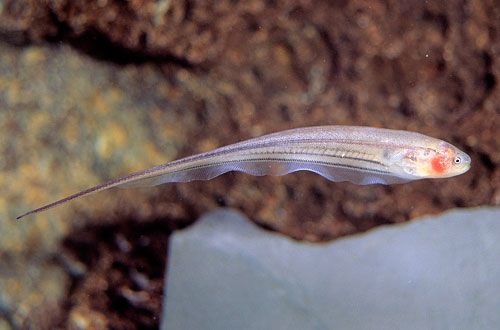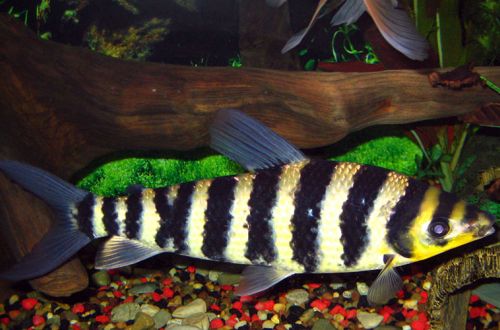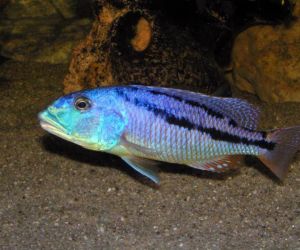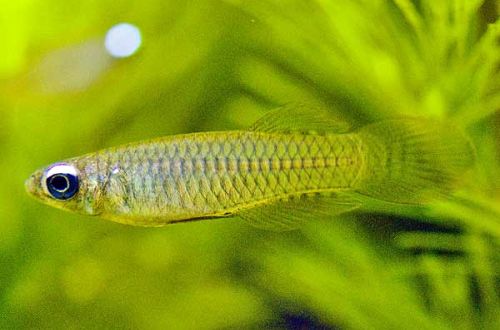
Fish “Glass Knife”
Fish “Glass Knife” or green Eigenmannia, scientific name Eigenmannia virescens, belongs to the family Sternopygidae. The name of this species comes from the unusual shape of the body of the fish. Outwardly, it resembles the blade of a knife or scalpel. With the correct setup of the aquarium, maintenance does not cause trouble. May be recommended for beginner aquarists.

Contents
Habitat
It comes from South America, is found in almost the entire vast Amazon basin. They live in the main channel of rivers and their tributaries, streams and floodplain lakes. Successfully adapted to life in conditions of strong and weak currents. They live near the bottom, prefer regions with dense aquatic vegetation and numerous snags.
Brief information:
- The volume of the aquarium – from 200 liters.
- Temperature – 20-30°C
- Value pH — 6.0–7.0
- Water hardness – soft to medium hard (2-15 dGH)
- Substrate type – sandy
- Lighting – subdued, dim
- Brackish water – no
- Water movement – light or moderate
- The size of the fish is 45 cm.
- Nutrition – live and frozen food
- Temperament – peaceful
- Content in a group of 5 individuals
- Lifespan up to 6 years
Description
Adult males reach a length of about 45 cm, females are much smaller – only up to 20 cm. Otherwise, sexual dimorphism is weakly expressed and, apart from size, males and females are practically indistinguishable. A characteristic feature of this species is the shape of the body, resembling a knife blade, which is reflected in the name. The fish lacks a dorsal fin, and the tail has become a vestigial organ. But the anal fin stretches all over the body. Thanks to the wave-like movement, Eigenmannia green moves. And it can easily move both forward and backward. There is no coloration as such due to the translucent body.
The fish has a unique organ that generates a weak electromagnetic field, which helps to navigate in space and find food in bad conditions.
Food
Carnivorous species, in nature feeds on crustaceans, insects and their larvae, small fish. In a home aquarium, the diet should be similar and consist of, for example, fresh or frozen bloodworms, brine shrimp, earthworms, shrimp and mussel pieces. If desired, it is allowed to serve live small fish. Dry food is used in very limited quantities, mainly as a source of additional vitamins and trace elements.
Feeding is carried out after turning off the light.
Maintenance and care, arrangement of the aquarium
The optimal size of the aquarium starts from 200 liters. Since the Glass Knife fish is nocturnal, sufficiently dim lighting should be provided. The design uses a sandy substrate, a few snags and a dense vegetation cover. When choosing plants, preference should be given to shade-loving varieties.
Fish are sensitive to the quality and composition of the water. To maintain stable water conditions, you will need a productive filtration system and regular aquarium maintenance procedures: replacing some of the water with fresh water and cleaning it from organic waste. Often, in addition to filters, ultraviolet sterilizers are installed to prevent diseases.
Behavior and Compatibility
Timid and shy fish leading a hidden lifestyle. They belong to social species, prefer to stay in a group, so it is recommended to purchase at least 5 individuals. Compatible with other non-aggressive calm fish, but not too small, otherwise the latter may accidentally become a victim of Eigenmannia green.
Reproduction / Breeding
In nature, spawning occurs during the rainy season and for breeding in aquariums it is necessary to simulate such conditions. To implement this is quite difficult and hardly within the power of beginners and even experienced aquarists.
Fish diseases
Under favorable conditions, fish do not have health problems. The main causes of disease can be a sudden and significant deterioration in water quality, prolonged exposure to water with unsuitable pH and dGH values, contact with sick fish, etc. For more information on symptoms and methods of treatment, see the section Aquarium Fish Diseases.





